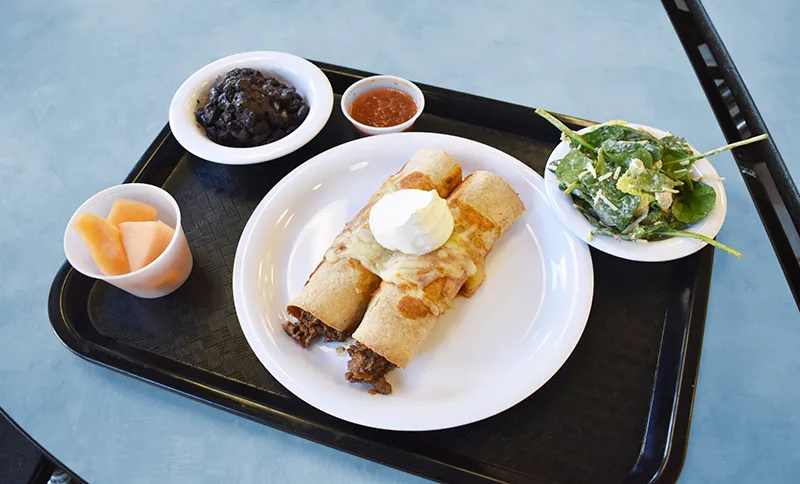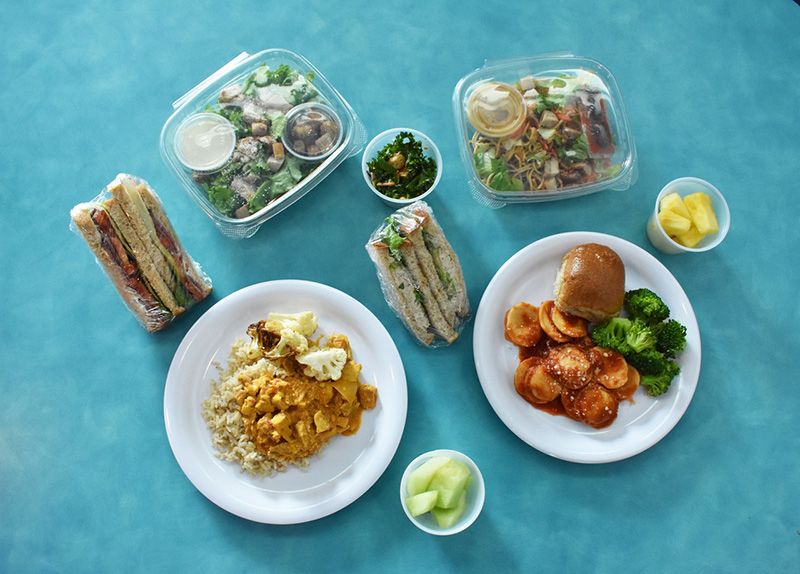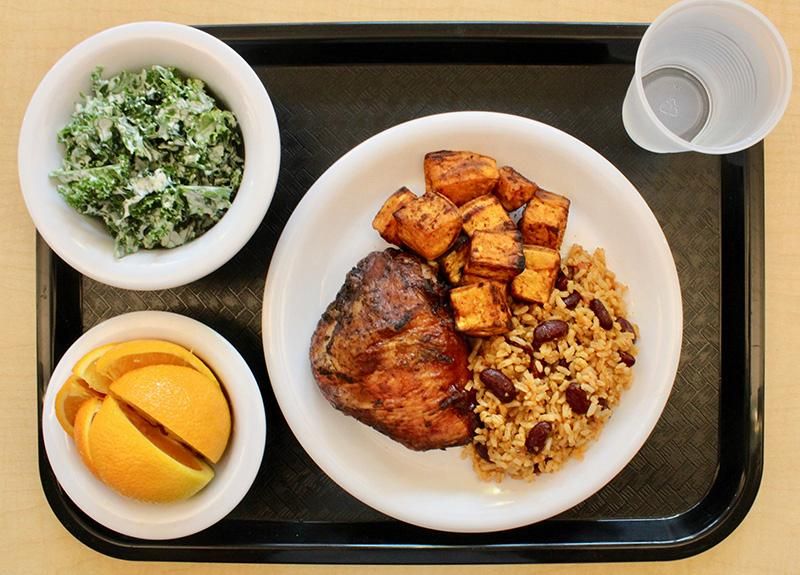This Former Noma Chef Is Revamping the School Cafeteria
Dan Giusti used to serve $500 lunches. Now he’s working to deliver meals on a kid’s budget.
:focal(576x214:577x215)/https://tf-cmsv2-smithsonianmag-media.s3.amazonaws.com/filer/02/d0/02d04d5c-04ce-442f-b5e5-5f40fb38a768/giusti.jpg)
Dan Giusti trained at the prestigious Culinary Institute of America and spent three years as head chef of Noma, the cutting-edge Copenhagen restaurant that’s earned two Michelin stars and is considered by many the best restaurant in the world. Tables fill up months in advance, and lunch can easily run $500.
But now, Giusti is focused on cooking for a slightly different clientele: schoolkids. His program, Brigaid, brings professional chefs into public school cafeterias to create made-from-scratch menus. Brigaid launched in the New London, Connecticut school system in 2016 and expanded to the Bronx last fall.
We talked to Giusti about what he’s learned since the program started, how he hopes to change kids’ attitudes towards food, and why butternut squash soup is no longer on the menu.
What did you see as the biggest problem with school food when you decided to start Brigaid?
There’s this misconception—people think that [the problem with] school food is all about the nutrition. But all school food has to meet standard nutritional guidelines. The real problem is that the kids aren’t eating the food because it’s not tasty. In a nutshell, the idea was that the food doesn’t taste good, there’s not enough thought put into the food itself. If you could make food consistently that met the nutritional guidelines and the budget and that tasted very good to the kids, then you would be in great shape.
What are some of the changes you have made to the menu?
We took all those processed things—chicken nuggets, chicken tenders—and we put on raw meats we cook from scratch, so that we can control how they’re cooked and seasoned. We make all our own pasta sauces. We make a lot of baked goods ourselves. You’re not just appealing to a kids’ tastes when you’re cooking—kids can smell things that are happening. We serve them warm; it’s just a different experience.

What is something that has been a hit with the kids?
It was such a simple thing, but we saw the consumption of fruit just spike up because we went from serving whole pieces of fruit that were not really good quality—kids weren’t interested in eating a whole apple that wasn’t very nice, or fruit that was frozen or canned—to serving fresh fruit that’s been cut daily. That really encouraged kids to eat fruit, which they really weren’t eating. Which was really strange because kids—most people—eat fruit. The baked goods we do, kids love. Certainly things that are more traditional like pizza—we make our own dough, and kids really love the pizza that we make. They recognize that a good amount of work goes into it. We do composed salads where we assemble a salad like a chicken Caesar or Cobb, and they just take it and put dressing on it. In a school of 700 or 800 kids we can sell 100 in a day. We like our kids wanting to eat salads, so that’s really cool.
What were some notable failures?
Things that didn’t work? There are tons. It’s a challenge. When we started, we had lots of kids inquire about fish. We managed to create a relationship with a purveyor out of Boston who supplied us with fresh fish. It was a pretty amazing thing, but just super-polarizing. A small percentage of kids enjoyed it, but a good portion of kids when they think fish, they think ‘fish sticks’—some kind of processed fish that’s breaded and fried. We’re not going to do that. If we revisit it, maybe there’s a way to mimic a fish stick.
We’ve done soups. Some soups are successful. But one soup was butternut squash that was pureed. Kids don’t want pureed soup. You find out when a kid spits it out on the ground.

What was one of your unexpected challenges?
The challenging thing is not letting your own tastes get in the way. We made a lot of changes we thought were appropriate, and it made sense to take away processed foods. But sometimes those changes are deterrents. Taking a chicken patty off the menu that kids really enjoyed, because it’s a processed product, could really hurt you in terms of getting food that children will eat.
The biggest challenge, honestly, is that there’s a big discrepancy about the perception of what 'good' food is between parents, administrators, teachers, etc. People have this idea in their head, everything should be organic, everything should be this or that. But sometimes we serve very basic things because we want to make the kids feel comfortable, and sometimes people are disappointed about that, almost underwhelmed. It’s not about 'look what we got the kids to eat!' Lunch should be the last place that kids feel stressed out. We want to make sure the kids are eating, and that they feel good about it. If that’s happening, then we can use that environment to get them to try new things.
Public schools don't have the budgets of high-end restaurants. How do you keep costs down?
Well, it's a lot of experimenting. You kind of have to rethink how you cook. You need to find less expensive ways to develop and add flavor. For example, as a chef, you are very accustomed to using a lot of fresh herbs. We cannot really afford that, so instead we use a lot of dried spices and herbs.
How do you hope the program might change kids’ relationships to food in the long run?
Oftentimes, people are trying to get kids to really think deeply about things regarding food. Seasonal, local—that’s fine. But kids’ appetites for [learning about food culture] might not be there just yet. You need to sell them on the food first. Our idea is slowly but surely introducing new items so they trust you and they’ll continue to try things. We’ve seen this already with the kids that we’ve been with for three years. You can see that their attitude towards trying things or not trying things is much different than what we saw when we first came. They’re just experienced with eating.
The goal on a day-to-day basis is to make these kids feel comfortable and really provide them with a meal that makes them feel good and helps them get through their day.

You’re hiring trained chefs. What’s the appeal to them of working in a school cafeteria?
The initial appeal is that it’s weekends off, it might be a shorter day, you might have holidays off, which is a huge change from working in the hotel or restaurant industry. That’s a benefit, but by no means do we want people choosing this job solely for that reason. Chefs want a challenge—it’s their personality. To come day in and day out and solve a problem that’s very complicated.
What’s the difference between cooking for schoolkids and cooking for the kind of people who eat at restaurants like Noma?
I think the biggest difference is kids are honest. They have no reason not to be honest. They’ll tell you what they think, and sometimes they don’t have much of a filter and they say things that are difficult to hear. If you can get them to articulate why, you can really use that feedback. You can be upset about it, or take that and make improvements.
Adults, especially in a place like Noma, where people are waiting months to eat, it’s hard to get an honest opinion. They’ve waited all this time to eat in a restaurant, they’re there with their family, they don’t want to be the one who didn’t like the food because it’s almost like they feel they didn’t ‘get it.’
Do you remember eating in your own school cafeteria? Did you have any favorite dishes? Anything you hated?
I don’t even remember eating at all. I think it’s because for me, lunch was just a break period. At that time in my life food was very important—I came from an Italian family, I was used to eating well, and I was working in a restaurant full-time. But lunch was just a break period to talk to your friends. That’s indicative. If you don’t feel like food’s being prepared in a thoughtful manner, it’s just a break period.
I was fortunate to have access to good food outside of school. But there are a lot of kids who are coming to the cafeteria who don’t have access to good food—or food—outside of that lunch. So it’s even more imperative that we put as much of our thought into it as we can.
/https://tf-cmsv2-smithsonianmag-media.s3.amazonaws.com/accounts/headshot/matchar.png)
/https://tf-cmsv2-smithsonianmag-media.s3.amazonaws.com/accounts/headshot/matchar.png)